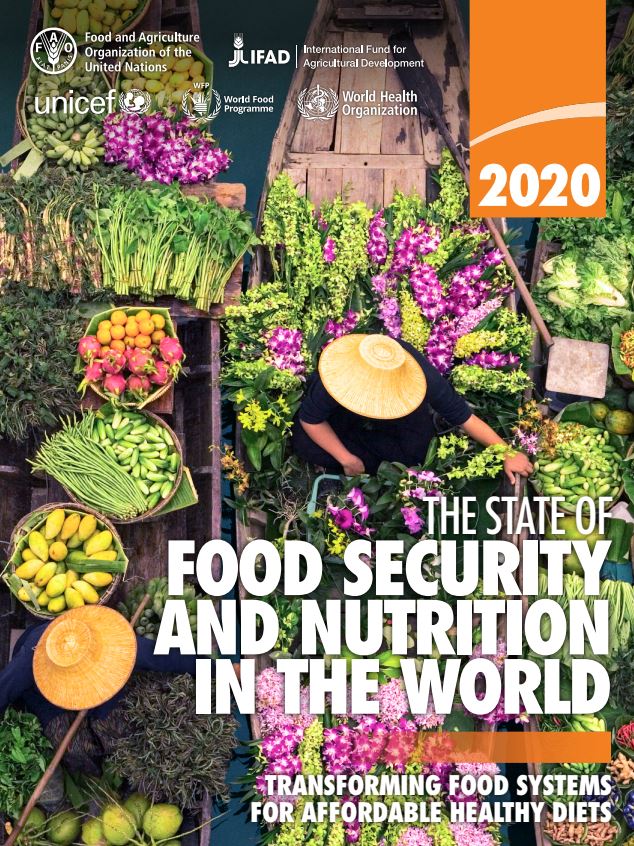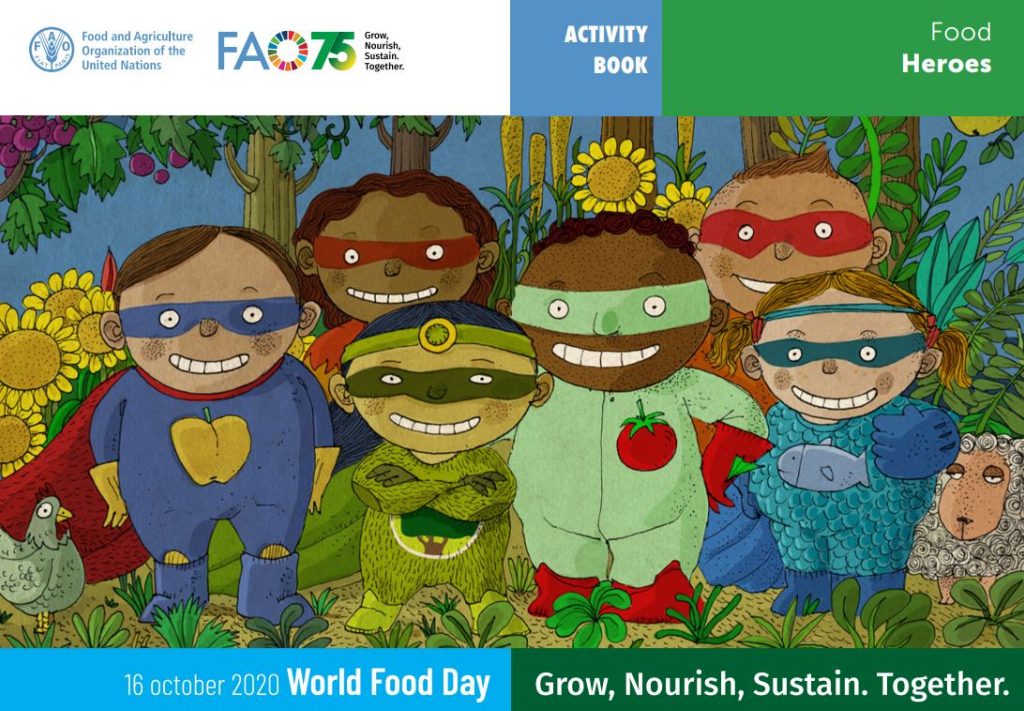Quick-fire activities and videos to get you started on teaching the issues, the debates and key ideas around World Food Day, by Toni Pyke
- World Food Day 2020 materials and coverage – a series in partnership with Scoilnet, Concern Worldwide, Self Help Africa and developmenteducation.ie

This year marks the 40th World Food Day (WFD) since the dedicated day was established in 1981. The focus of WFD is to raise global awareness of the issues surrounding poverty and hunger around the world. This year, the focus is on sustainability and global solidarity in the struggle to end world hunger and malnutrition.
2020 also marks the 75th anniversary of the Food and Agriculture Organisation of the United Nations (FAO), the oldest permanent specialised agency of the United Nations, founded the same year as the United Nations. The FAO:
“leads international efforts to defeat hunger…. achieve food security for all and make sure that people have regular access to enough high-quality food to lead active, healthy lives” (FAO.org – see 10 achievements of the FAO; Short history of FAO here).
Three years later in 1948, the UN Declaration of Human Rights recognised the ‘right to food’ (Article 25) as a fundamental human right for every individual on our planet. In 1961, the FAO established the World Food Programme (WFP) as its humanitarian operation to respond to the various hunger crisis around the world through food assistance and food aid (see 12 things you didn’t know about the WFP).
This year, hunger was a key theme for the Norwegian Nobel Committee who conferred the prestigious Nobel Peace Prize to the World Food Programme:
“for its efforts to combat hunger, for its contribution to bettering conditions for peace in conflict-affected areas and for acting as a driving force in efforts to prevent the use of hunger as a weapon of war and conflict… turn the eyes of the world to the millions of people who suffer from or face the threat of hunger” (Chairwoman Norwegian Nobel Committee Berit Reiss-Andersen)
Watch the very moment the 2020 Nobel Peace Prize was announced.
Presented by Berit Reiss-Andersen, Chair of the Norwegian Nobel Committee.
See the full announcement: https://t.co/xcZrqV2Gvf#NobelPrize #NobelPeacePrize pic.twitter.com/uw7nqakZeb
It is fascinating that the World Food Programme has, for nearly 60 years, been trying to eradicate hunger and the need for food aid across the world. The WFP report that:
“In 2019, WFP assisted 97 million people – the largest number since 2012 – in 88 countries.
On any given day, WFP has 5,600 trucks, 30 ships and nearly 100 planes on the move, delivering food and other assistance to those in most need. Every year, we distribute more than 15 billion rations at an estimated average cost per ration of US$ 0.61”.
And despite this effort, it seems that we are not on target to meet the 2030 SDG 2 target of ‘Zero Hunger’.
The State of Food Security and Nutrition 2020 reports that:
“five years after the world committed to end hunger, food insecurity and all forms of malnutrition, we are still off-track to achieve this objective by 2030″.
8 Hunger Statistics
- 690 million people went hungry in 2019 – up by 10 million from 2018, and by nearly 60 million over a five-year period
- If current trends continue, the number of hungry people will reach 840 million by 2030
- The COVID-19 pandemic and the various economic impacts caused by the measures to combat the virus, could add an additional 83 to 132 million more people into chronic hunger by the end of the year (see impact on refugees in Uganda: The Guardian)
- 144 million children around the world suffer from stunting, a sign of chronic undernutrition; 47 million children suffer from wasting, a sign of acute undernutrition and 5.3 million children died before their fifth birthdays, in many cases as a result of undernutrition (2019).
- Some 38 million under-fives were overweight
- According to the FAO – the cost of malnutrition is US$3.5 trillion per year
- The most undernourished populations in the world live in Asia (381 million); Africa (250 million) and Latin America (48 million). However, given current trends, by 2030, Africa will be home to more than half of the world’s chronically hungry
- A third of the food produced in the world is either lost or wasted
Source: World Health Organisation; FAO; Global Hunger Index
Note: The definition and understanding of ‘hunger’ includes ‘chronic’ hunger and malnutrition – which incorporates undernutrition, micronutrient deficiencies, overweight and – obesity.
The 2020 update – who has access to nutritious food?
The key issues today include not only securing food for survival – but also nutrition. It is not only important that an individual has enough food to eat, but that food needs to be nutritious to enable a healthy life. This adds another dimension to ‘hunger’. Many families cannot afford the rising costs of what are considered nutritious foods for a health diet.

According to the State of World Food Insecurity report 2020, a healthy diet is well beyond the reach of the 689 million people who are living on less than the international poverty threshold of US$1.90 a day.
Even at higher poverty lines – those who live on less than US$3.20, nearly a quarter of the population on the planet (24.1%) cannot afford a healthy diet; compared to 43.6 % of the global population who live on less than $5.50.
The report shows that the price of the least expensive healthy diet is five times the price of filling stomachs with starch only. Nutrient-rich dairy, fruits, vegetables and protein-rich foods (plant and animal-sourced) are the most expensive food groups globally. Some 3 billion people or more cannot afford a healthy diet. This is leading to a ‘global pandemic’ of obesity.
Also, hunger is not just about food – the world produces more than enough food to feed everyone. According to the FAO, ‘our food systems are out of balance’. The complex, interconnected web of issues include: poverty, equal access to healthcare, a quality education, access to justice and human rights, conflict and war, the rights of women and girls, climate change/environmental degradation, loss of agro-biological diversity, food loss and food waste, and a lack of security for food chain workers.
Learning materials & activities
Here are a few kick-starter ideas and exercises to get the key ideas, debates and issues relating to food, hunger, nutrition, consumption and production.
Take the Great World Food Day Quiz 2020!
Watch the WFD “Be a Food Hero” video (60 seconds)
Read
A guide to 5 quick activities on World Food Day, by Colm Regan
Read: World Food Day 2020 Activity Book: Food Heroes

“Did you know that the majority of the world’s food is produced by small-scale farmers? Most of the food you eat comes from a farm, whether it’s a crop, animal, dairy, fish or other type of farm. But farmers aren’t the only food heroes out there. From the cultivation of food to its arrival at your table, different food heroes are involved every step of the way.
Discover the important role these heroes play and the digital innovations that are helping them and our food systems to perform better. Find out what each of us – governments, farmers, businesses and the general public – can do to improve how our food is produced and learn how you can make a difference!”
As part of WFD 2020 the FAO are promoting ‘Food Heroes’ and are encouraging each of us to be ‘food heroes’ too by:
- choosing a ‘healthy and diverse’ diet;
- influence positive will – through social media promote healthy eating and buying habits;
- join initiatives – be an ally to food heroes by volunteering;
- choose local/choose seasonal/grow food at home;
- respect food and food heroes – reduce food loss and waste;
- support development initiatives – school meals/nutrition programmes/raise awareness of healthy eating;
- support food related business and retailers – become a food activist and lobby for transforming food systems, technologies and those employed in the sector.
See: FAO Interactive hunger map – See global progress towards the eradication of hunger and malnutrition.
Read: Conflict and Hunger 2-page fact sheet by the WFP- WFP
5 videos - Watch, discuss, act.
Take a look at one of these short videos to open up introductory discussions
The State of Food Security and Nutrition in the World 2020
“We are facing a global fight to address one of the biggest challenges of our time. Five years after committing to eradicate hunger we are not on track to reach our goals by 2030. Chronic hunger is up by 10 million people in one year and up by nearly 60 million in five years. Almost 690 million people went hungry in 2019, with numbers highest in Asia [381 million] and rising fastest in Africa [250 million].
What causes hunger?
An animation exploring some of the reasons why hunger exists in our modern world, and how we can help.
The Paradox of Hunger in the World, by SOS Faim
An animation comparing ‘hunger’ in 3 countries – Bolivia, Congo, Ethiopia – who are food producers and yet experience hunger. Explores the root causes of ‘hunger’ in our planet, such as trade liberalisation policies, energy policies, common agricultural policies, etc., and what we can do about it.
Why do people still go hungry? by Guardian animations
There is enough food in the world to go around, yet hundreds of millions of people go to bed each night on an empty stomach. World leaders have promised to end hunger by 2030. But what causes it and how do we prevent it?
Actor Dougray Scott explains.
Sustainable Solutions to End Hunger, by Ceres2030
Details how donor governments must spend an additional USD 14 billion a year collectively on average until 2030 to end hunger, double the incomes of 545 million small-scale farmers, and limit agricultural emissions in line with the Paris climate agreement.
This means roughly doubling the amount of aid given for food security and nutrition each year, and must also be accompanied by an additional USD 19 billion a year from low- and middle-income countries’ own budgets.
Read the report here
Stay tuned for more World Food Day 2020 materials and coverage – a series developed in partnership with Scoilnet, Concern Worldwide, Self Help Africa and developmenteducation.ie

